Maths Olympiad Previous Year Paper - 2 | Math Olympiad for Class 5 PDF Download
| Table of contents |

|
| Logical Reasoning |

|
| Mathematical Reasoning |

|
| Everyday Mathematics |

|
| Achievers Section |

|
Note: The questions provided in this document are similar to the questions that were asked in the actual Olympiad exam. So, we recommend you study these for your Olympiad preparation
Logical Reasoning
Q1: If ‘School’ is referred to as ‘Home’, ‘Home’ is referred to as ‘Office’, ‘Office’ is referred to as ‘Market’ and ‘Market’ is referred to as ‘Bus stop’, then we purchase vegetables from ________.
(a) Office
(b) Market
(c) Bus stop
(d) Home
 View Answer
View Answer 
Ans: (c)
- In this scenario, we need to follow the renaming of places.
- Since Market is now called Bus stop, it means that we buy vegetables from the Bus stop.
- Thus, the correct answer is Bus stop.
- Remember, the original meaning of Market has shifted to Bus stop in this context.
Q2: Chetna ranked 19th from the bottom in a class of 25 students. What is her rank from the top in the class?
(a) 6th
(b) 7th
(c) 5th
(d) 8th
 View Answer
View Answer 
Ans: (b)
- To find Chetna's rank from the top, we need to calculate how many students are above her.
- Since there are 25 students in total and she is ranked 19th from the bottom, that means there are 6 students below her.
- Therefore, her rank from the top is 25 - 6 = 19.
- To find her rank from the top, we subtract her bottom rank from the total number of students: 25 - 19 + 1 = 7.
Q3: There is a specific connection between the terms on both sides of the ::. Determine the relationship of the left pair and identify the missing term.
SOF : UQH :: IMO : ?
(a) KQO
(b) JOQ
(c) KOQ
(d) GKM
 View Answer
View Answer 
Ans: (c)
- The relationship between the terms SOF and UQH involves a pattern of shifting letters. Each letter in SOF is shifted forward by a certain number of places in the alphabet to get UQH.
- For example, S (19) becomes U (21), O (15) becomes Q (17), and F (6) becomes H (8). This shows a shift of +2 for each letter.
- Applying the same logic to IMO, we shift each letter forward by 2: I (9) becomes K (11), M (13) becomes O (15), and O (15) becomes Q (17).
- Thus, the missing term that corresponds to IMO is KOQ.
Q4: Direction (4 & 5): Study the following information carefully and answer the questions.
L, M, N, O, P, Q and R are sitting in a row facing north.
L is sitting at the right end and R is sitting at the left end.
Q is the immediate right of P. N is 4th to the right of R.
N is the neighbour of M and O. O is third to the left of L.
Who is/are to the left of N?
(a) Only M
(b) R and M
(c) O, P, Q and L
(d) R, M an d O
 View Answer
View Answer 
Ans: (b)
R and M are to the left of N.
Q5: Which of the following statements is not true?
(a) L is at one of the ends.
(b) Q is sitting between P an d L
(c) P is to the immediate right of N
(d) R is at one of the ends.
 View Answer
View Answer 
Ans: (c)
Q6: How man y triangles are there in the following figures?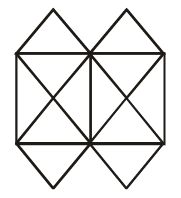 (a) 20
(a) 20
(b) 22
(c) 16
(d) 24
 View Answer
View Answer 
Ans: (b)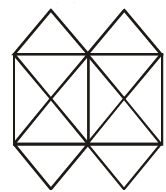 Smallest triangle - AEI, BIF, EKI, EGK, GKJ, IKJ, GJC, FLH, JLH, JLI, ILF, and JDH ie-12.
Smallest triangle - AEI, BIF, EKI, EGK, GKJ, IKJ, GJC, FLH, JLH, JLI, ILF, and JDH ie-12.
Contains two triangle - EIJ, EGJ, EGI, GIJ, IJH, EJH, IHF, FJH ie 8.
Contains 4 triangles - EJF and GIJ ie 2.
Total no. of triangle - 12 + 8 + 2 = 22
Q7: How many pairs of letters are there in the word "PREAMBLE" which have as many letters between them in the words as they have between them in the English alphabet?
(a) None
(b) One
(c) Two
(d) Three
 View Answer
View Answer 
Ans: (c)
Q8: D h as a sister A, whose moth er is P. D is the daughter of P. B is P's mother. In term of relationships what is A to B ?
(a) Daughter
(b) Sister
(c) Cousin
(d) Granddaughter
 View Answer
View Answer 
Ans: (d)
The relation diagram is as follows: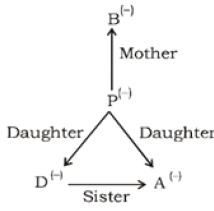
A is Granddaughter to B.
Q9: A house faces North. A man coming out from the house walked straight for 10 m, turned left and walked 25 m. He then turned right and walked 5 m and again turned right and walked 25 m. How far is he from his house ?
(a) 15 m
(b) 55 m
(c) 60 m
(d) 65 m
 View Answer
View Answer 
Ans: (a)
The direction diagram is as follows: Required distance = AE = AB + BE
Required distance = AE = AB + BE
(Here, CD = BE = 5m) = 10m + 5m = 15 m
Q10: If in a code language KAMLESH is written as GUJLMCO. Then, how can NATURAL be written in that code?
(a) TCNUPCV
(b) TCOUPVC
(c) TCUOPVC
(d) TCOUVC
 View Answer
View Answer 
Ans: (a)
As,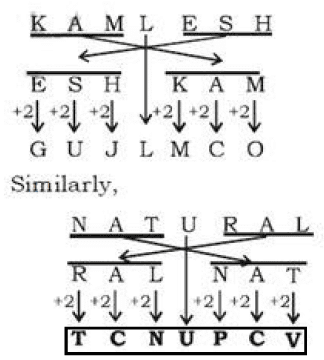
Q11: Select the missing number from the given alternatives.
(a) 3
(b) 14
(c) 5
(d) 16
 View Answer
View Answer 
Ans: (c)
As, (2 + 3 + 4)2 = 81
(4 + 2 + 5)2 = 121
Similarly,
(1 + 5 + 7)2 = 169
Q12: 30 members of a club decided to play a badminton singles tournament. Every time a member loses a game he is out of the tournament. There are no ties. What is the minimum number of matches that must be played to determine the winner?
(a) 29
(b) 31
(c) 35
(d) 27
 View Answer
View Answer 
Ans: (a)
Clearly, every time except one ( i.e. the winner) must lose one game to decide the winner.
So, minimum number of matches to be played = 30 - 1 = 29.
Q13: Naman is ranked 14th from the top and Ricky is ranked 17th from the bottom in a class of 40 students. How many students are there between Naman and Ricky?
(a) 8
(b) 9
(c) 10
(d) 7
 View Answer
View Answer 
Ans: (b)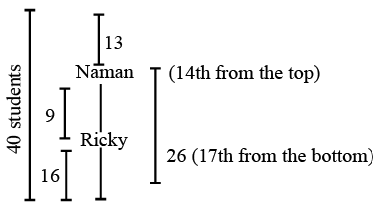 Number of students between Naman & Ricky.
Number of students between Naman & Ricky.
Q14: If a person is walking towards North, what direction should he follow so that he is walking towards West?
(a) right, right, left
(b) left, left, right
(c) left, right, left
(d) left, left, left
 View Answer
View Answer 
Ans: (b)
The direction of a person is as follows:
Q15: Mohit correctly remember s that his father's birthday is not after eighteenth of April. His sister correctly remembers that their father's birthday is before twentieth but after seventeenth of April. On which day in April was definitely their father's birthday?
(a) Seventeenth
(b) Nineteenth
(c) Eighteenth
(d) Seventeenth or Eighteenth
 View Answer
View Answer 
Ans: (c)
According to Mohit:
April 18 or earlier ... (i)
According to his sister:
April 18 or 19 ... (ii)
From (i) and (ii), we get April 18
Mathematical Reasoning
Q16: Which of the following options is organized in descending order?
(a) 5034; 7056; 80431; 10569
(b) 82540; 72042; 42035; 10568
(c) 6051; 10268; 24561; 54685
(d) 1029; 50552; 30251; 44162
 View Answer
View Answer 
Ans: (b)
- The correct answer is option (b) because the numbers are arranged from the highest to the lowest: 82540, 72042, 42035, and 10568.
- In contrast, the other options do not follow this descending order.
- For example, option (a) starts with 80431 but then goes to 7056, which is lower, breaking the order.
- Thus, option (b) is the only one that maintains a consistent decreasing sequence.
Q17: How many packets of 750 g each can be obtained from a 30 kg sack of pulses?
(a) 36
(b) 40
(c) 55
(d) 60
 View Answer
View Answer 
Ans: (b)
- To find out how many packets of 750 g can be made from a 30 kg sack, first convert 30 kg to grams: 30 kg = 30,000 g.
- Next, divide the total grams by the weight of each packet: 30,000 g ÷ 750 g = 40.
- This means you can pack 40 packets of 750 g each from the 30 kg sack.
- Thus, the correct answer is 40 packets.
Q18: The value of 78.80 + 19.45 – 17.20 is __________.
(a) 84.75
(b) 76.50
(c) 81.05
(d) 73.50
 View Answer
View Answer 
Ans: (c)
- First, we add 78.80 and 19.45, which gives us 98.25.
- Next, we subtract 17.20 from 98.25, resulting in 81.05.
- Thus, the final answer is 81.05.
Q19: If P = CMXLIX and Q = CMLXVIII, which of the following statements is true?
(a) P > Q
(b) P < Q
(c) P = Q
(d) Cannot be determined
 View Answer
View Answer 
Ans: (b)
- To compare P and Q, we first convert the Roman numerals to Arabic numbers.
- P = CMXLIX equals 949 and Q = CMLXVIII equals 968.
- Since 949 is less than 968, we conclude that P < Q.
- Thus, the correct answer is (b) P < Q.
Q20: The total capacity of containers A and B is 30.32 L. If the capacity of containers A, B, and C altogether is 46.06 L, then the capacity of container C is:
(a) 15.74 L
(b) 12.58 L
(c) 19.36 L
(d) 16.49 L
 View Answer
View Answer 
Ans: (a)
- To find the capacity of container C, we need to subtract the total capacity of containers A and B from the total capacity of A, B, and C.
- The total capacity of A and B is 30.32 L and the total capacity of A, B, and C is 46.06 L.
- So, the capacity of container C is calculated as 46.06 L - 30.32 L = 15.74 L.
- Thus, the capacity of container C is 15.74 L, which corresponds to option (a).
Q21: Determine the largest 5-digit number that can be created using all unique digits with 4 positioned in the hundreds place.
(a) 98476
(b) 98765
(c) 98746
(d) None of these
 View Answer
View Answer 
Ans: (a)
- To find the greatest 5-digit number, we need to use the digits 0-9 without repeating any.
- Since 4 must be in the hundreds place, we can use the digits 9, 8, 7, 6, 5, 3, 2, 1, 0 for the other places.
- To maximize the number, we should place the largest digits in the thousands, ten-thousands, and units places.
- Thus, the largest arrangement is 98476, which uses 4 in the hundreds place and all other digits are different.
Q22: 56 (4 + 2) = (56 × 4) + (56 × 2) is an example of the
(a) closure property of whole number
(b) commutative property of whole number
(c) associative property of whole number
(d) distributive property of whole number
 View Answer
View Answer 
Ans: (d)
Q23: The product of 1st natural, 1st whole and the 1st prime number is equal to
(a) 5
(b) 0
(c) 9
(d) 7
 View Answer
View Answer 
Ans: (b)
1st natural number = 1
1st whole number = 0
1st prime number = 2
Then, the product is 1 × 0 × 2 = 0
Q24: The sum of the prime numbers between 90 and 100 is
(a) 188
(b) 281
(c) 376
(d) 97
 View Answer
View Answer 
Ans: (d)
The only prime number between 90 and 100 is 97.
Q25: HCF and LCM of two numbers are 12 and 72 respectively. If the difference of the numbers is 60, then the larger number is:
(a) 12
(b) 60
(c) 24
(d) 72
 View Answer
View Answer 
Ans: (d)
Let the numbers be a and b.
∴ Product of numbers = LCM × HCF
ab = 72 × 12 ...(1)
and a – b = 60
a = 60 + b
Then, from (1), b (60 + b) = 12 × 72
⇒ b = 12
a = 60 + b = 72
Larger number is 72.
Q26: In which of the following prime factorisation is not completed?
(a) 70 = 2 × 5 × 7
(b) 28 = 2 × 2 × 7
(c) 48 = 2 × 2 × 2 × 2 × 3
(d) 108 = 2 × 2 × 27
 View Answer
View Answer 
Ans: (d)
Complete factorisation is 108 = 2 × 2 × 3 × 3 × 3
Q27: A quadrilateral is a rhombus but not a square if
(a) its diagonals do not bisect each other
(b) its diagonals are not perpendicular
(c) opposite angles are not equal
(d) the length of diagonals are not equal
 View Answer
View Answer 
Ans: (d)
Q28: In which of the following figures the adjacent sides are not necessarily be equal?
(a) Parallelogram
(b) Rhombus
(c) Equilateral Triangle
(d) Square
 View Answer
View Answer 
Ans: (a)
Q29: The number of line segments in the shown figure is (a) 30
(a) 30
(b) 20
(c) 15
(d) 12
 View Answer
View Answer 
Ans: (c)
Q30: Number of lines passing through five points such that no three of them are collinear is
(a) 10
(b) 5
(c) 20
(d) 8
 View Answer
View Answer 
Ans: (a)
Q31: Which of the following statement (s) is/are true?
(a) In a trapezium the diagonals bisect each other
(b) In a rectangle diagonals intersect at right angles
(c) The diagonals of a rhombus are equal
(d) None of these
 View Answer
View Answer 
Ans: (d)
All the given statements are false.
Q32: Where does the vertex of an angle lie?
(a) In its interior
(b) In its exterior
(c) On the angle
(d) None of these
 View Answer
View Answer 
Ans: (c)
The vertex lies on the angle.
Q33: The infinite number of lines that can pass through a given point are called.
(a) Concurrent lines
(b) Parallel lines
(c) Perpendicular lines
(d) None of these
 View Answer
View Answer 
Ans: (a)
Q34: If a quadrilateral with two pairs of adjacent sides equal but opposite sides are not equal then it is called
(a) parallelogram
(b) square
(c) rectangle
(d) kite
 View Answer
View Answer 
Ans: (d)
Q35: Which one of the following is a pair of supplementary angles?
(a) 30º, 180º
(b) 100º, 140º
(c) 105º, 75º
(d) All of these
 View Answer
View Answer 
Ans: (c)
Everyday Mathematics
Q36: A family consumes 1 9/20 L of oil each week. Calculate the total amount of oil the family will use in February of a regular year.
(a) 4 3/4 L
(b) 5 4/5 L
(c) 3 3/4 L
(d) 3 4/5 L
 View Answer
View Answer 
Ans: (b)
- February has 4 weeks in a normal year.
- The family uses 1 9/20 L of oil weekly, which is the same as 29/20 L.
- To find the total for February, multiply 29/20 L by 4 weeks: (29/20) * 4 = 116/20 L.
- When simplified, 116/20 L equals 5 4/5 L.
- Thus, the total quantity of oil used by the family in February is 5 4/5 L.
Q37: A tailor uses two different colored fabrics measuring 67.75 cm and 89.68 cm to create a dress. What is the total length of fabric used by the tailor for the dress?
(a) 136.43 cm
(b) 142.84 cm
(c) 152.84 cm
(d) 157.43 cm
 View Answer
View Answer 
Ans: (d)
- To find the total length of fabric used, we need to add the lengths of the two pieces of cloth.
- The lengths are 67.75 cm and 89.68 cm.
- When we add these two lengths together: 67.75 + 89.68 = 157.43 cm.
- Thus, the total cloth used by the tailor to make the dress is 157.43 cm.
Q38: The cost of fencing a rectangular garden at ₹15 per meter is ₹2100. If the breadth of the field is 20 m, then its length is ______.
(a) 50 m
(b) 40 m
(c) 70 m
(d) 30 m
 View Answer
View Answer 
Ans: (a)
- The total cost of fencing is ₹2100, and the cost per meter is ₹15. To find the total length of the fence, we divide the total cost by the cost per meter: 2100 / 15 = 140 meters.
- The formula for the perimeter of a rectangle is 2 * (length + breadth). Here, the breadth is given as 20 m.
- Using the perimeter formula: 140 = 2 * (length + 20). Simplifying gives us length + 20 = 70, so length = 70 - 20 = 50 m.
- Thus, the length of the garden is 50 m.
Q39: In an electronic store, there are 450 electronic products. Among these, 5/18 are electric fans, while the remaining are other products. How many other products are available in the store?
(a) 185
(b) 325
(c) 275
(d) 260
 View Answer
View Answer 
Ans: (b)
- First, calculate the number of electric fans: 450 * (5/18) = 125 fans.
- Next, find the number of other items by subtracting the number of fans from the total: 450 - 125 = 325.
- Thus, the total number of other items in the shop is 325.
Q40: An experienced stock broker invested ₹8,75,684; ₹8,75,713; ₹8,81,312, and ₹8,57,995 in four different shares P, Q, R, and S respectively. In which share did he invest the least amount?
(a) P
(b) Q
(c) R
(d) S
 View Answer
View Answer 
Ans: (d)
- The stock broker made investments in four shares: P, Q, R, and S.
- The amounts invested were ₹8,75,684 for P, ₹8,75,713 for Q, ₹8,81,312 for R, and ₹8,57,995 for S.
- Among these amounts, the smallest investment is ₹8,57,995, which corresponds to share S.
- Thus, the share with the least investment is S.
Q41: A university charges ₹5,658 per student for a specific course. If 45 students enrolled for the course, then find the total amount collected by the university for that particular course.
(a) ₹1,82,560
(b) ₹2,54,610
(c) ₹1,68,740
(d) ₹2,24,530
 View Answer
View Answer 
Ans: (b)
- To find the total amount collected, we need to multiply the fee per student by the number of students.
- The fee per student is ₹5,658 and the number of students is 45.
- So, the calculation is: ₹5,658 x 45 = ₹2,54,610.
- This means the university collected a total of ₹2,54,610 for the course.
Q42: The weight of Akshara is 57.89 kg. If Sandeep weighs 16.47 kg more than Akshara, what is the combined weight of Akshara and Sandeep?
(a) 168.36 kg
(b) 89.93 kg
(c) 132.25 kg
(d) 74.36 kg
 View Answer
View Answer 
Ans: (c)
- To find the total weight of Akshara and Sandeep, first calculate Sandeep's weight by adding 16.47 kg to Akshara's weight of 57.89 kg.
- Sandeep's weight = 57.89 kg + 16.47 kg = 74.36 kg.
- Now, add Akshara's weight to Sandeep's weight: 57.89 kg + 74.36 kg = 132.25 kg.
- Thus, the total weight of Akshara and Sandeep is 132.25 kg.
Q43: A company earned ₹5648000 in a year. If the total expenses were ₹474596, then how much money was saved?
(a) ₹234467
(b) ₹6137007
(c) ₹5234728
(d) ₹5173404
 View Answer
View Answer 
Ans: (d)
- To find the amount saved, we need to subtract the total expenses from the total earnings.
- The total earnings are ₹5648000 and the total expenses are ₹474596.
- So, the calculation is: ₹5648000 - ₹474596 = ₹5173404.
- This means the company saved ₹5173404 after covering its expenses.
Q44: Mukul bought two T-shirts priced at ₹719 each and a cap costing ₹348. He paid the shopkeeper with a ₹2000 note. What will be the change Mukul receives from the shopkeeper?
(a) ₹306
(b) ₹186
(c) ₹214
(d) ₹197
 View Answer
View Answer 
Ans: (c)
- First, calculate the total cost of the T-shirts: 2 * ₹719 = ₹1438.
- Next, add the cost of the cap: ₹1438 + ₹348 = ₹1786.
- Now, subtract the total cost from the amount paid: ₹2000 - ₹1786 = ₹214.
- Thus, the shopkeeper will return ₹214 to Mukul.
Q45: How many numbers are there containing 2 digits?
(a) 90
(b) 99
(c) 100
(d) 89
 View Answer
View Answer 
Ans: (a)
(Greatest two digit number-smallest two digit number) = (99 – 10) + 1 = 89 + 1 = 90
Achievers Section
Q46: Which digit in the number 568731 has a place value of thousands?
(a) 8
(b) 7
(c) 6
(d) 5
 View Answer
View Answer 
Ans: (a)
Place value of 8 is 8000.
Q47: Which one of the following numbers in Roman numerals is correct?
(a) CLDL
(b) VDC
(c) LDC
(d) CDLX
 View Answer
View Answer 
Ans: (d)
Q48: Which of the following is not defined?
(a) 5 + 0
(b) 5 – 0
(c) 5 × 0
(d) 5 ÷ 0
 View Answer
View Answer 
Ans: (d)
Q49: Whole numbers are not commutative under ________.
(a) Multiplication
(b) Subtraction
(c) Addition
(d) Both multiplication and addition
 View Answer
View Answer 
Ans: (b)
Q50: The difference of L.C.M. and H.C.F. of the numbers 40, 240 and 480 is equal to twice a number. Find the number.
(a) 340
(b) 440
(c) 220
(d) 880
 View Answer
View Answer 
Ans: (c)
|
37 videos|109 docs|51 tests
|
FAQs on Maths Olympiad Previous Year Paper - 2 - Math Olympiad for Class 5
| 1. What topics are generally covered in the Maths Olympiad for Class 5? |  |
| 2. How can I prepare effectively for the Maths Olympiad? |  |
| 3. Are the questions in the Maths Olympiad multiple-choice or descriptive? |  |
| 4. What is the importance of logical reasoning in the Maths Olympiad? |  |
| 5. How can I access previous year papers for the Maths Olympiad? |  |




















